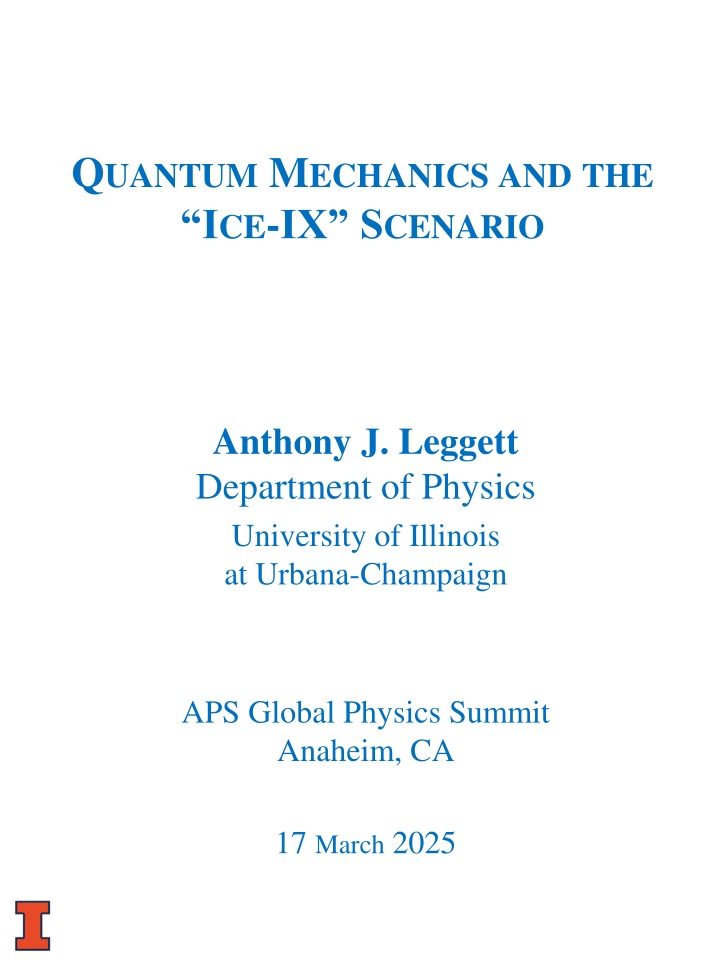
Quantum Mechanics and the Ice-IX Scenario by Anthony J. Leggett
Explore the fascinating concept of the Ice-IX scenario as discussed in Quantum Mechanics by Anthony J. Leggett. Delve into the implications of ice-IX stability, energy release, and quantum tunnelling, raising questions about safety and physical implementation in this intriguing field of study.
Download Presentation

Please find below an Image/Link to download the presentation.
The content on the website is provided AS IS for your information and personal use only. It may not be sold, licensed, or shared on other websites without obtaining consent from the author. If you encounter any issues during the download, it is possible that the publisher has removed the file from their server.
You are allowed to download the files provided on this website for personal or commercial use, subject to the condition that they are used lawfully. All files are the property of their respective owners.
The content on the website is provided AS IS for your information and personal use only. It may not be sold, licensed, or shared on other websites without obtaining consent from the author.
E N D
Presentation Transcript
QUANTUM MECHANICSANDTHE ICE-IX SCENARIO Anthony J. Leggett Department of Physics University of Illinois at Urbana-Champaign APS Global Physics Summit Anaheim, CA 17 March 2025
IX-2 THE ORIGINAL ICE-IX SCENARIO * (at time of writing) 8 solid phases of H2O known, all stable only for ? 0 C. But there is a 9th phase (ice-IX) stable at room temperature so far, has never occurred in nature. Mad scientist makes in laboratory, dumps in ocean Oceans promptly (at speed of sound) freeze worldwide Noteworthy features of the ice-IX scenario: 1. Transition hypercooled (propagation not limited by diffusion of latent heat) (cf 3He A B) 2. Enormous energy release on transition 3. Existing phases of H2O extremely metastable against transition to ice-IX In real life, many mini-examples (e.g. nuclear weapons) How safe are we against accidental occurrence? in particular, by quantum tunnelling a) in standard QM b) in modified theory * K. Vonnegut, Cat s Cradle, Delacorte Press, New York 1963 pp. 45-50.
thermal IX-3 Vmax V x ?? metastable ? more stable state state Escape probabilities: ?~? ??? ? , ?? ~??? ?? = ???????~ ? ??? 1 2 2?? ? ??~2(2? ?) 1 2 ???? = 0 = 2 ? Escape by tunnelling favored (for given T) by high, short barriers For typical macroscopic numbers ?~???? ????, ?~?? ,?~1??, ~10?? ??? ?? ?? tunnelling negligible compared to thermal activation (which itself corresponds to ?? ~3 1020) But what about physical implementation of control code? e.g. in (semiclassical) Josephson 2-state system, ???~ ????? 3 1 2 ~1023??? 1 2 (can be < ?? for accessible ?) What P is effectively zero? with ???~ a few GHz, B~75 67 ?~ 10 15?? ? The formula ???? = 0 ~ ?????. ? ? is valid for a single degree of freedom with effective mass ?. 60 10 9?? ?? 10 12?? (or e.g. for EM circuit, M C) 1 2? What if the system is coupled to an environment? Does ??? increase of decrease?
IX-4 For single DOF, Does dissipative coupling to environment increase or decrease B? ???? = 0 ~?????.(? ?) 1 2? Suppose bare ???? = ??, effective ???? = ????, relaxation time for ?? ????~?. Then a) in collisionless limit (???? 1), effect of dissipation is ? = ?? (unchanged), ? unchanged, L increases ? increases b) in hydrodynamic limit ???? 1 , ? unchanged, L unchanged, M decreased B decreases More quantitatively* 1 + ???? ? ? ?~?????. 1 + ???? ?????? so near collisionless limit ? ? ~? ?? + ?, ?/? ??~ ???? near hydrodynamic limit ? ? ~? ? ?, ?/? ? ~???? 1 11 ?????? ?????? hydrodynamic limit is dangerous! A further thought: are QM prediction actually right ? ?2 in an ice IX situation (huge release of energy in tunnelling transition)? Without a proper quantum theory of measurement, we cannot be sure! One future of QM: applications on macroscopic scale! *cf. A.J. Leggett, Phys. Rev. B 30, 1208 (1984)
